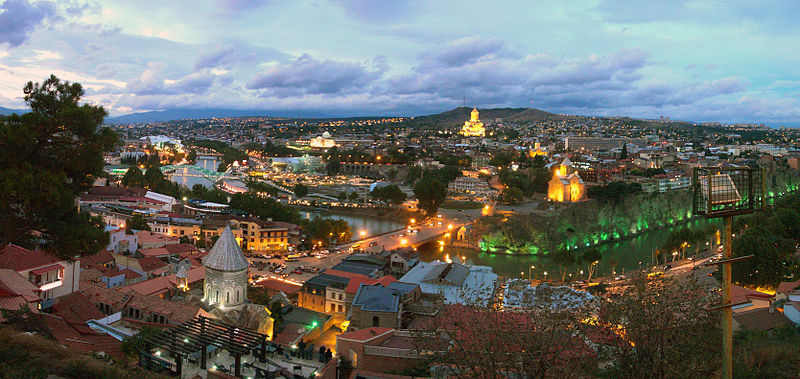Si buscas
hosting web,
dominios web,
correos empresariales o
crear páginas web gratis,
ingresa a
PaginaMX
Por otro lado, si buscas crear códigos qr online ingresa al Creador de Códigos QR más potente que existe



History
First time According to legend, the current territory of Tbilisi was covered by forests until 458. A variant of the legend of the foundation of Tbilisi widely accepted is that King Vakhtang I Gorgasali of Georgia went hunting in this region with a falcon. The King's falcon allegedly caught a pheasant during the hunt, after both animals fell near hot springs and died scalded. King Vakhtang became so impressed with the hot springs that he decided to clear the forest and build a city there. The name derives from the Old Tbilisi Georgian word meaning Tpili hot water, and therefore was given to the city because of the many hot springs había.Estudios archaeological sulphurous have revealed that the area was inhabited in 4000 BC We also know that the peopling of the area was during the second half of the fourth century AD, when a fortress was built during the reign of Varaz-Bakur. Towards the end of the fourth century, the fortress fell to the Persians, after the area fell to the king of Kartli (Georgia) in the middle of the fifth century King Vakhtang is primarily responsible for founding and building the city
Designation as capital
King Dachi I Ujarmeli (early s.VI) was the successor of Vakhtang I Gorgasali and moved the capital from Mtskheta to Tbilisi. It should be mentioned that Tbilisi was not the capital of the unified territory of Eastern Georgia but only because the territory of Colchis not belong to the kingdom. During his reign, Dachi completed construction of the fortress wall and delimited the new borders of the city. In early s.VI, Tbilisi started to notice a period of peace because of the situation as favorable and strategic crossroads between Europe and Asia.
Foreign domination
The period of peace ended and the strategic position of Tbilisi was disputed among several regional empires: Persia, the Byzantine Empire, Arabia and the Seljuk Turks. The cultural development of the city was heavily dependent on who ruled the city at that time. Although Tbilisi, Georgia and East were generally able to maintain a certain degree of autonomy from its conquerors, the foreign domination began in the latter half of s.VI and ended well into the sX From the 570 to the 580, the Persians ruled Tbilisi. In the year 627, Tbilisi was sacked by the Byzantine and Khazar armies. 736 to 738, Arab armies entered the town under the command of Marwan II Ibn-Muhammad. After this, the Arabs established an emirate in Tbilisi. Note that the Arabs brought a certain order to the region and introduced a modern judicial system in Georgia. In 764, Tbilisi, still under Arab control was once again sacked by the Khazars. In the year 853 the armies of Arab leader Al-Turki Bugha invaded Tbilisi to establish a caliphate. The Arab domination of Tbilisi continued until 1050 because of failure to expel Georgians. Tbilisi was sacked again, but this time only in 1068 by the Seljuk Sultan Alp Arslan under.
Tbilisi as the capital of the united Georgian state
In 1122, after fierce fighting that involved some 60,000 Georgians against some 300,000 Turks, the troops of King David IV of Georgia entered Tbilisi. When the battle ended, the king moved his residence from Kutaisi, western Georgia to Tbilisi, which was declared the capital of the united kingdom of Georgia. In the twelfth and thirteenth centuries, Tbilisi became a dominant regional power with a thriving economy, a well-developed trade and a strong social structure. At the end of the twelfth century, Tbilisi had a population of about 80,000 inhabitants. The city was also a cultural and literary very important not only in Georgia but throughout the known world. During the reign of Queen Tamara, Shota Rustaveli worked in Tbilisi while writing his legendary epic poem, The Knight in the Panther's Skin. This period is often called the Golden Age of Georgia or the Georgian Renaissance.
Mongol domination and the following period of instability
The golden age of Tbilisi did not last more than a century. In 1226 Tbilisi was captured by the Empire and their defenses corasmio were devastated by the Mongol army. In 1236 Georgia came under Mongol rule. The nation had a form of semi-independence and did not lose their way of life. But Tbilisi was strongly influenced by the Mongols both politically and culturally. By the year 1320, the Mongols were expelled by force and Tbilisi once again became the capital of Georgia again. In 1366 due to the Black Death, the city was razed as many otras.Desde late eighteenth century until the late fourteenth century, Tbilisi was captured by various invaders and on several occasions was completely burnt. In 1366 the city was conquered by Tamerlane. In 1444 it was invaded and destroyed by Jahan Shah of the Persian city of Tabriz. Between 1477 and 1478 the city was conquered by the Ak Koyunlu tribe of Uzun Hassan. In 1522, Tbilisi came under Persian control but was recaptured in 1524 by King David X of Georgia. During this period, many parts of the city were rebuilt. During the seventeenth and eighteenth centuries, Tbilisi was, yet again, the object of rivalry, this time of Ottoman Turks and Persians. King Erekle II of Georgia tried several occasions, successfully, to free Tbilisi from Persian but in the end the city was burned to the ground in 1795 by Agha-Mohammad Khan. It is at this time when, aware that Georgia can not fight alone against Persia, Erekle II sought the help of Russia.
Tu Sitio Web Gratis
© 2025 Visit a little amazing country81766